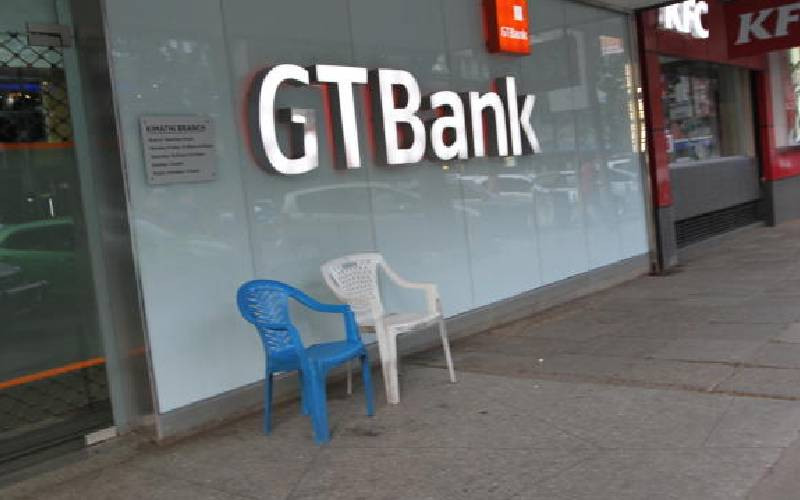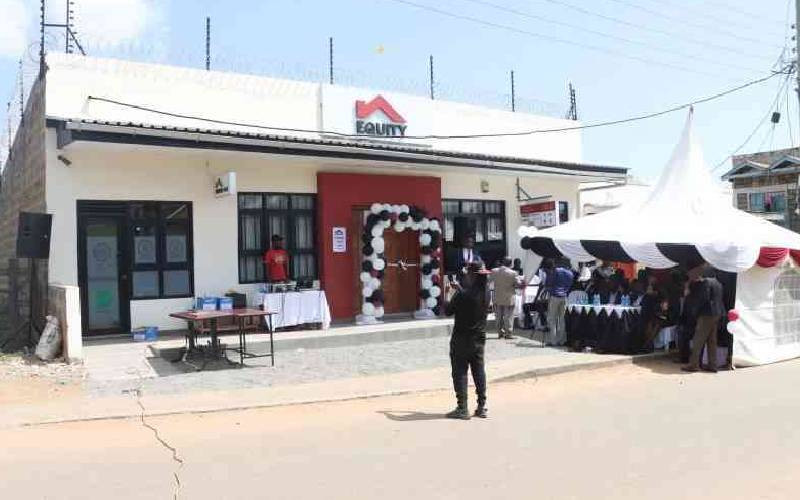Less than 24 hours after Rita Oyier was crowned Kenya’s most influential personality on social media, an extraordinary package was delivered to her office.
The relationship manager at her bank sent a large bouquet of flowers that left her in awe. Her award had nothing to do with the institution she had trusted with her money for two years.
“These were not just your ordinary red flowers ... I felt loved,” Ms Oyier, an entrepreneur and customer at Chase Bank, told Business Beat.
The two weeks the lender has been closed have been difficult, she said, but she spent time seeking divine intervention for the speedy reopening of a bank she had introduced to family and friends.
“I did not believe God would let this bank go. It is like family to very many of us,” said the managing director of Monar Strategic, a Nairobi-based digital marketing agency.
The warm affection for Chase Bank Oyier has is heard many times over in conversations with the lender’s customers. The bank, to their relief, reopens tomorrow, 16 days after it was placed under receivership.
Paul Ndeti, 42, a farmer and businss executive, said he routinely received end-year gifts from the bank, felt treasured by its officials and appreciated the lender’s flexibility with overdrafts and loans to his business. So the first thing he will do tomorrow when Chase reopens?
“I’ll deposit money,” he said.
Strong bond
The lender had fashioned itself as “The relationship bank” and had over time built a strong bond with its clientele, mostly small and medium-sized enterprises (SMEs) run by entrepreneurs like Rita.
Chase Bank had particular appeal to business owners ranked in the upper-middle class category. And while they may not have had millions in their accounts at one go, they had hundreds of thousands of shillings flowing in and out, as their clients paid and they paid their suppliers.
A lot of these kinds of entrepreneurs needed overdraft facilities, which Chase Bank readily provided. An overdraft allows clients to withdraw cash from their current accounts up to a specified limit after depleting their own money. The bank earns interest on this kind of lending.
This profile of customers helps explain why Chase Bank had 97 per cent of its accounts — 167,290 of them — holding less than Sh1 million.
Another aspect that attracted SMEs to Chase was its convenience: little paperwork and an efficient online platform, which meant banking could be done from the office.
Titus Rotich, 33, an electronics dealer, opened an account at a Chase Bank opposite his office. The bank was so accommodating of his business needs that he had got to the point where he could trust its staff to make mobile money payments on his behalf.
Stay informed. Subscribe to our newsletter
“They went out of their way for me. If I walked into the banking hall and the branch manager was around, she would come out to come say hi,” said Mr Rotich.
“My account doesn’t hold plenty of money for long due to the nature of my business, but it did not seem to matter to them. It was enough that I banked at Chase.”
More deposits
And like Mr Ndeti, Oyier and Rotich plan to visit their bank branches tomorrow in a show of loyalty, an attribute that looks set to hold Chase in good standing as it begins a new journey under the management of Kenya Commercial Bank.
Even KCB Group CEO Joshua Oigara believes reopening Chase Bank will illustrate the lender’s successful engagement with its customers.
“We do believe that when it reopens, we will actually get more deposits. I don’t expect a run on deposits,” he told The EastAfrican.
This kind of relationship with depositors is something not many lenders have been able to achieve, which drew plenty of attention when the proposal to rescue Chase Bank was floated.
“Over the past decade, Chase Bank has created a strong and loyal SME, upper-middle income and youthful customer base,” Francis Mwangi, a research analyst at Standard Investment Bank(SIB), said.
“The bank’s success in banking SMEs has seen it attract multiple lines of funding from DFIs [development finance institutions] and other international lenders.”
Chase Bank made the strategic decision to focus on SMEs in 2005. The success of this strategy is partly captured by its branch expansion. Between 1996 — when Chase opened its doors — and 2012, the bank grew to have 30 branches. This means it opened, on average, just about two branches a year.
But between 2013 and 2015, Chase Bank expanded aggressively, opening 25 outlets to hit 55 branches in total, according to its website. This works out to about eight branches a year. These new outlets were opened in prime locations favoured by the upper middle class, such as Nairobi’s Karen, Parkland and Yaya, as well as major towns around the country.
Interestingly, one of the bank’s Nairobi branches was at Adlife Plaza, where there was a desk manned by a Chinese employee, perhaps an indication that the lender was targeting the population of Chinese business people living around Hurlingham and Kilimani. A tactical move. Just like its reputation for hiring young, attractive tellers, relationship managers and customer service officers.
In the weeks leading to Chase Bank being placed in receivership, African Development Bank had agreed to lend the bank Sh5 billion, a transaction that, if completed, may have changed how things played out when a run on deposits occurred.
Still, just days after the lender’s doors were closed by the Central Bank of Kenya (CBK), several suitors lined up offering a bailout in exchange for a stake.
Among them were two international banks, believed to be from Paris and Qatar, five local banks and an investment firm. KCB was unveiled on Wednesday as the successful bidder after submitting the best framework for revival.
Mr Oigara has since said his focus is to retain the bank he expects to acquire as it is, including its name and the staff.
“What I love about Chase is its uniqueness ... Chase has a strong distinct culture and that is what excites us. In no way will Chase become KCB and vice versa. This diversity is the value we are looking for,” he told The EastAfrican.
KCB’s proposed acquisition plans will be fully known once a due diligence exercise is completed in an anticipated six months.
In the meantime, KCB will act as the managers of Chase Bank, which will remain in receivership for 12 months, or until additional capital is invested.
CBK defended the move to appoint a receiver manager, saying it was necessary to protect depositors and other creditors’ interests, following allegations of unsound transactions at the bank and the subsequent resignations of the group chairman and managing director.
Panic spread among depositors, prompting a run on the bank, in a speedy sequence of events that translated to its failure to meet its financial obligations on April 6.
Big customers
Major lenders, however, sees the value in the bank, which was founded by Zafrullah Khan, who bought collapsed United Bank about 21 years ago for Sh95 million and transformed it into Chase Bank.
Its growth since can be described as spectacular, considering its total assets, consisting mainly of loans to customers, had grown to more than Sh142 billion by January 1, 2016.
Revelations about the profile of the bank’s depositors,who include 27,000 SME customers and 147 Saccos with more than 1.3 million members, illustrate how aggressively the bank worked to recruit big customers. In fact, just 3 per cent of its depositors hold 94 per cent of deposits.
Several big depositors had upwards of Sh500 million in their accounts, which could be explained by the relatively higher interest Chase offered at about 10 per cent.
Typically, it is the bigger and more established lenders that are recipients of such amounts, helped in part by inherent or perceived strength.
The continued receipt of such huge term deposits helped Chase to emerge as the lender of choice for small businesses and investment groups— specifically women through its Chase Woman product.
It came as no surprise last year when Marianne Nyangi, who heads Chase Woman, received a rare invitation from the White House to speak at the Global Entrepreneurship Summit in Nairobi, which was co-hosted by President Uhuru Kenyatta and US President Barrack Obama.
Ms Nyangi sat in a panel of five discussing, among other issues, how to enhance the capacity of women in business to grow their enterprises.
The downsides
And in the days that followed, the bank’s chief executive Paul Njaga shared his vision with The Standard in an early morning interview held at his office along Riverside Drive.
Mr Njaga, who was head-hunted for the job from QNP Paribas Investment Bank in London, projected that new loans to small businesses over the next three years would cross Sh60 billion.
It was difficult to see how a fairly small bank could amass sufficient resources for this feat.
But as the interview progressed, Njaga revealed that nearly all of his existing borrowers were servicing their relatively big loans steadily — meaning most of the money would be recovered in a short time.
The turnover was swift, partly because the borrowers were businesses keen to repay their debts and then come back for even bigger loans.
“We are having a very good experience with our SME customers,” Njaga said, adding, “women are the best borrowers for this bank.”
Women are less likely than men to deviate from their original plans when they borrow cash, according to Njaga’s findings. And men tend to be bigger risk-takers, raising the chances of their making a disastrous investment decision.
Aggressive lending at Chase Bank, however, had its downside.
An SIB report indicates that Chase had stretched its capitalisation beyond regulatory thresholds by the end of last year. The bank’s tier 1 capital adequacy levels stood at 9.3 per cent, against a regulatory requirement of 10.5 per cent.
Tier 1 capital is the shareholders’ claim in the bank, which includes the original investment plus retained earnings. Capital adequacy ratios (CAR) measure the ability of a bank to absorb losses without being insolvent, and continue to operate.
Mr Mwangi of SIB cautions in his report of anticipated challenges that the takeover and acquisition portends for KCB, which he describes as “a good suitor ... for now, [but] just on paper.”
“While the unprecedented move to appoint KCB manager of its competitor is well intended, especially in restoring confidence in the banking system, execution of the current mandate and eventual acquisition will not be easy, in our view,” he said, citing potential legal hurdles.
Mwangi warned appointing KCB a manager ahead of a full due diligence review of Chase Bank significantly complicates and undermines the standing of the planned acquisition as an arm’s-length transaction. This is because existing shareholders could easily seek legal redress in the event acquisition negotiations are skewed against them — whether true or perceived — given CBK’s interest in having the transaction concluded.
 The Standard Group Plc is a
multi-media organization with investments in media platforms spanning newspaper
print operations, television, radio broadcasting, digital and online services. The
Standard Group is recognized as a leading multi-media house in Kenya with a key
influence in matters of national and international interest.
The Standard Group Plc is a
multi-media organization with investments in media platforms spanning newspaper
print operations, television, radio broadcasting, digital and online services. The
Standard Group is recognized as a leading multi-media house in Kenya with a key
influence in matters of national and international interest.
 The Standard Group Plc is a
multi-media organization with investments in media platforms spanning newspaper
print operations, television, radio broadcasting, digital and online services. The
Standard Group is recognized as a leading multi-media house in Kenya with a key
influence in matters of national and international interest.
The Standard Group Plc is a
multi-media organization with investments in media platforms spanning newspaper
print operations, television, radio broadcasting, digital and online services. The
Standard Group is recognized as a leading multi-media house in Kenya with a key
influence in matters of national and international interest.









